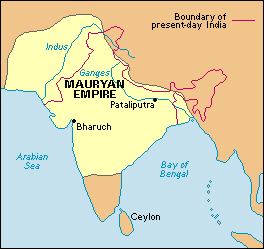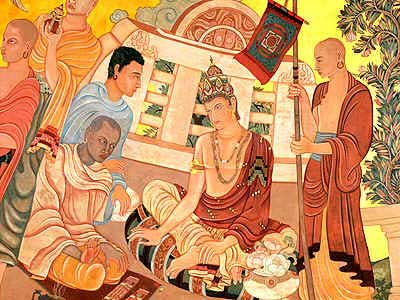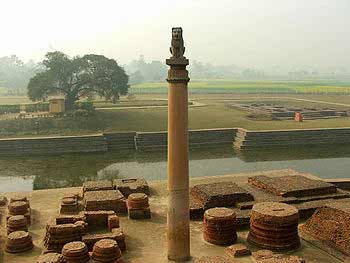
Ancient Indian war-elephants
Neil Faulkner Archive | ETOL Main Page
Marxist History
Published online by Counterfire, 6 September 2010.
Copied with thanks from the Counterfire Website.
Marked up by Einde O’Callaghan for the Encyclopaedia of Trotskyism On-Line (ETOL).
Neil Faulkner looks at the growth of the Mauryan Empire which at its zenith encompassed almost the whole of what is today India, Pakistan, and Bangladesh.

Ancient Indian war-elephants |
The people of the Indus Valley, however, remained largely immune to the influence of the agriculturalists for three millennia. Until about 4000 BCE, the continuing natural abundance of the alluvial flood-plain made the toil of farming unnecessary.
Thereafter, the spread of farming was rapid. During the fourth millennium BCE, the Indus Valley filled with agricultural villages. In the middle of the third, the huge surpluses generated by river-valley cultivation sustained an ‘urban revolution’. The Indus became one of only four places in the world where independent civilisations existed in the Early Bronze Age.
Around 2000 BCE, after only half a millennium of existence, Mohenjo-daro, Harappa, and the other Indus cities were abandoned. Early Bronze Age civilisation in the Indian sub-continent collapsed under its own weight. Over-accumulation by urban-based elites probably crippled the reproductive capacity of an agricultural economy based on tools of wood and stone.
To the north, a very different culture developed among the nomadic pastoralists of the Central Asian steppes. This vast territory was a band of grassland hundreds of miles deep extending from the Carpathians in the west to Manchuria in the east. Because of a combination of low rainfall, bitterly cold winters, and baking hot summers, agriculture made slow progress on the steppes.

The Mauryan Empire in 250 BCE |
The steppe-nomads domesticated the horse, invented the horse-drawn cart, developed the composite bow, and produced stunning artefacts of copper, bronze, silver, and gold. Formidable natural warriors, the steppe-nomads were the world’s finest horse-archers.
Life on the steppes was precarious. The numbers of people, the size of herds, and the adequacy of pasture were in fine balance. If a hot summer burnt out the grasslands, war, displacement, and mass migration might follow. Then, the steppe-peoples might impact on the wider world with torrential force.
Periodically, but unpredictably, they poured out of Central Asia, heading west, south, and east, from desiccated grasslands to fat plough-lands, seeking food and fodder, plunder and riches, and new land on which to settle. Such were the Mongols of the 13th century CE (common era), the Huns of the 5th century CE, and the Hsiung-nu against whom the Chinese built the Great Wall in the 3rd century BCE.
Long before, in the years around 1500 BCE, the Aryans left the steppes, crossed the mountain passes of the Hindu Kush, and entered the Indus Valley of north-west India.
They came first as nomadic-pastoralist invaders, relatively few in number, and their lifestyle and culture seem to have continued as before. Over the centuries, however, they spread across the Northern Plain into the Ganges Valley, and later again, southwards into the Deccan.
By then, they had iron, which reached India around 800 BCE, enabling the Indo-Aryans (a thoroughly mixed population by now) to hack down forests and jungles and cover northern and central India with farms.
The Aryans introduced horses, chariots, and the warrior culture of conquerors. The Hindu religion was conservative, ritualised, and populated by fearsome power-deities. The caste system fossilised the new social hierarchy forged by war. The Aryans were warriors (kshatriyas), priests (brahmans), and landowners (vaishyas). A fourth caste, the shudras, were mixed-race peasants. New groups were integrated into Aryan-Hindu society through a growing mass of sub-castes.
Hinduism legitimised the caste system. The social order was a natural order, divinely approved, and advancement was an individual matter. The virtuous were those who conformed; they would be reincarnated in a higher caste. Dissidents, on the other hand, could expect relegation in the next life.
The invaders also brought their language: Sanskrit. This is a variant of the Indo-European group of languages from which most modern European languages derive. In India, however, the caste system prevented popularisation of language: Sanskrit became the language of the educated elite.
 Chandragupta |
Iron technology filled the Ganges Valley with rich farms, powerful monarchies, and large armies. For some three centuries, rival states battled for supremacy. By 321 BCE, when Chandragupta Maurya usurped its throne, Magadha had emerged as the strongest of these states. One Greek writer estimated its army strength to be 200,000 infantry, 20,000 cavalry, 2,000 chariots, and 3,000 elephants.
Between 321 and 303 BCE, Chandragupta conquered the Ganges Valley, the Northern Plain, and the Indus Valley. His immediate successors waged further wars of conquest in southern India, and by 260 BCE the Mauryan Empire encompassed almost the whole of what is today India, Pakistan, and Bangladesh.
Mauryan conquest was violent. The Kalingans were the last to hold out, but the Mauryan emperor Ashoka crushed them totally, and ‘150,000 people were deported, 100,000 were killed, and many times that number perished ...’
Exploitation of conquered territory was systematic. Slaves (usually war-captives) were employed in mining, construction, industry, and household service. Peasants toiled on the land. The government maintained dams, reservoirs, and canals. Individual peasants paid rents on their plots and taxes on their produce. Merchants and artisans also paid various taxes and tolls.

Power architecture and stone-inscribed decrees asserted |
The Mauryan Empire was a military superstructure resting on a base of tribute-paying peasants and petty-traders. This is clear from the Arthashastra, a treatise on government and economics from the reign of Chandragupta. All land was owned by the emperor, and all peasants owed him tribute. The only intermediaries were state-appointed officials.
The empire was divided into provinces, these were sub-divided into districts, these into groups of villages, and the smallest unit was the village. Each village had a headman. Each group of villages had an accountant and a tax-collector. And so on up the hierarchy, with subordinates accountable to those above them, not those below.
A network of informers spied on people and reported dissidents to the authorities. Ashoka (269–232 BCE), the emperor who completed the Mauryan conquest and then shaped the imperial administration, attempted to achieve an overarching ideological hegemony by promoting the concept of Dhamma.
A conservative form of Buddhism, Dhamma stressed toleration and the suppression of differences in the interests of social harmony. It was an attempt to freeze-dry the contradictions of Mauryan society.
It did not work. In the 50 years after Ashoka’s death, the Mauryan Empire broke up. There were tensions between Hindu and Buddhist sections of the ruling class. Subjugated states rebelled. External enemies broke off fragments of territory.
The military superstructure had been huge. One Roman writer quotes figures of 600,000 infantry, 30,000 cavalry, and 9,000 elephants. But the Mauryan state was a hastily-assembled amalgam without the glue of a unified ruling class, a common culture, and good communications.
The Persian Empire was destroyed by foreign conquest. The Mauryan Empire imploded for lack of internal coherence. The Ch’in Empire, by contrast, was destined to last for 2,000 years. To that we now turn.
Neil Faulkner Archive | ETOL Main Page
Eleven Reasons to Fight
Last updated on: 13 February 2022